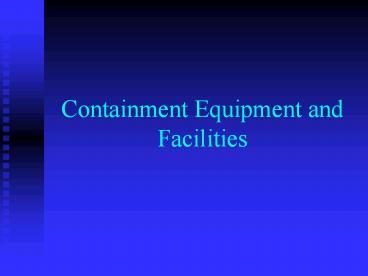Containment Equipment and Facilities - PowerPoint PPT Presentation
1 / 18
Title:
Containment Equipment and Facilities
Description:
... Primary Barrier Primary barriers contain the agent at the source Equipment/Engineering Control Biological safety cabinet ... Laminar Flow Hoods ... – PowerPoint PPT presentation
Number of Views:128
Avg rating:3.0/5.0
Title: Containment Equipment and Facilities
1
Containment Equipment and Facilities
2
Biocontainment
- The principle of holding or being capable of
holding or including within a fixed limit or area
- Preventing the unintentional release of
biological agents through a combination of
laboratory practices, containment equipment
(primary barrier) and laboratory facility design
(secondary barrier)
3
Primary Barrier
- Primary barriers contain the agent at the source
- Equipment/Engineering Control
- Biological safety cabinet, fumehood, glove box,
animal housing, centrifuge, fermenter
4
Secondary Barrier
- Secondary barrier is the structure surrounding
the primary barrier - Facility/Engineering Control
- Rooms, building
- Types of Facilities
- Basic laboratory
- Containment laboratory
5
Primary Barriers - Equipment
- Personnel Protection
- Any aerosol generated within the cabinet is
contained and kept away from the researcher - Product Protection
- Air within the work space of the cabinet has been
filtered so that is is virtually free of airborne
particles and organisms thus protecting the work
from outside contamination - Environmental Protection
- Aerosols generated within the unit are removed
from the air before the air is discharged
6
Ventilation EquipmentClasses and Types
7
Chemical Fume Hood
- 100 fpm face velocity
- Offer only personnel protection
- Always exhaust air to the outside
- Do not offer protection to the product or the
environment, as there is no filtration of intake
and exhaust air (Sometimes air cleaning treatment
is added to the exhaust.) - Do draw contaminants in the laboratory air
directly over the product being worked on - Used for work with chemical hazards
8
Any Comments?
Fumehood - keep hood clean, sash should be closed
when hood is not in use, equipment should be 9
from sash
9
Clean Bench / Laminar Flow Hoods
- Provide product protection only
- Product protection is provided by creating a
unidirectional airflow generated through a HEPA
filter - Discharge air goes directly into workroom
- Applications
- Any application where the product is not
hazardous but must be kept contaminant free - Preparation of non-hazardous intravenous
mixtures and media - Particulate free assembly of sterile equipment
and electronic devices - Eliminate Clean Bench in containment laboratory
10
Biological Safety Cabinets
- Designed to contain biological hazards
- Inward airflow for personnel protection
- HEPA filtered exhaust air for environmental
protection - Supply air HEPA filter for product protection
(except Class I) - Separated into Classes and Types
- Class I
- Class II
- Type A1, A2
- Type B1, B2
- Class III
- Microbiological studies, cell cultures,
pharmaceutical research and procedures
11
Class I Cabinet
- 75 fpm face velocity
- Provides personnel and environmental protection
- No product protection
- Requires an exhaust blower to pull the air
through - usually to the outdoors - Applications
- Housing centrifuges, fermenters
- Cage dumping in an animal lab
- Aerating cultures
12
Class II Cabinets
- Ventilated cabinet
- Provides personnel, product, and environmental
protection - Open front with inward airflow for personnel
protection - Downward HEPA filtered laminar airflow for
product protection - HEPA filtered exhaust air for environmental
protection
13
Any Comments?
BSC - remove unnecessary objects, keep grill at
front of cabinet unobstructed
14
Primary Barriers
Personnel Product Environment
Chemical Fumehood x
Laminar Flowhood x
Class I Biosafety Cabinet x x
Class II Biosafety Cabinet x x x
Class III Biosafety Cabinet x x x
Isolators x x x
15
Types of Biosafety CabinetsNSF/ANSI Standard 49
2002
16
Biological Safety Cabinet Certification
- First Certification
- Annually
- When moved
- When filter is changed
- When repaired or modified
- Note Certification is paid by the researcher,
not EHS
17
Other Primary Barriers- Engineering Control
- Gasketed blenders, homogenizers
- Cotton plugs, filters for flasks in shakers
- Filtered pipette tips
- HEPA and hydrophobic vacuum line filters
- Plasticware substituted for glassware
- Gas burners with shield, microincinerator
- Centrifuges
- Interlock, solid cover, safety buckets, O-rings
18
Secondary Barrier- Facilities
- Laboratory Biosafety Level 2
- Lockable doors (a must for restricted agents)
- Sink
- Bench tops impervious and easily cleaned
- Biological safety cabinet (if applicable)
- Eyewash
- Inward airflow (desirable)































